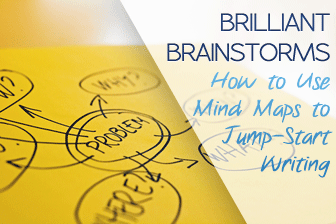Brilliant Brainstorms: How to Use Mind Maps to Jump-Start Writing


Very few native speakers will ever start writing at the top of the first page and continue straight through until they finish at bottom of the last one. The entire process has five steps, but the first step in the writing process is coming up with your thoughts and ideas, also known as prewriting. Prewriting helps students gather ideas and give them a bank of possibilities for their writing. This way, as students write they do not have to make decisions simultaneously about content and language. Help your students get a head start before they write with any of these six methods for prewriting. The bank of ideas they will generate will be an invaluable resource as they write.
Brainstorming
Brainstorming is an activity with which most people are familiar. The object in brainstorming is to compile as large a list as possible of potential examples for a given topic. This is a great activity to do in small groups or with the entire class. Brainstorming a list of ice cream flavors is an easy one to start with when introducing the concept. Naturally, one idea will spark another, so it is helpful to have students working together when brainstorming. Give your students permission to be as creative as they like. Anything goes with brainstorming. Challenge your students to come up with as many examples as they possibly can for whatever topic you give them.
Free writing
Free writing is an individual activity for getting thoughts from your head on to paper. Explain the concept of stream of consciousness to your students and tell them that free writing is simply putting on paper every thought that is going through their heads. Like with brainstorming, anything goes. The goal of this activity is to never let your pen or pencil stop writing. Help students understand that though they will begin with a particular topic in mind, it is okay to veer off on tangents as they write. Spelling and grammar are not important for this activity; it is ideas that we are trying to grasp. Give your students a set length of time for this activity. If they are young you may want to limit it to two or three minutes; older students can probably write for five to ten minutes. Then when students have completed the activity, have them go back and read what they have written digging through the mire for the gems hidden within.
Journalistic Questions
Journalistic questions approach a topic in a more structured manner. Start by reviewing the question words: who, what, where, when, why and how. Then, for your given topic, ask questions starting with each of these words. For example, if your topic was study habits, you might ask, “Who has good study habits? Who benefits from good study habits? What are the good habits? Where do people with good study habits study? Where to they keep their books? Where do they organize notes and homework? When do they study? When do they complete assignments? ...” There are an infinite number of questions you can ask about any given subject. This activity can be done either individually or in groups with success. Have students write answers to each question. When finished prewriting, have them go back and read what they have written and organize their thoughts in preparation for writing.
Cluster Mapping
Cluster mapping, also called idea webbing, is a great way to show relationships between ideas. Cluster mapping is also part idea generation and part organization, so students will know exactly how to group their ideas once they are ready to write. To begin, write your topic in the center of the page and put a circle around it. Then you can move in one of two directions. With younger children, have them think of questions about the topic. For example, if the topic is spiders, they may ask, “What do spiders eat? Where to spiders live? What do spiders look like?” Each question should be written in a bubble connected to the central topic. Tell students to spread these bubbles out over the page as they will be adding to each. Then, have students answer the questions connecting still smaller bubbles to the bubbles containing the questions. If their question was “What do spiders do?” then they might make connecting bubbles saying they capture flies, they spin webs, they scare nursery rhyme characters, etc. With students who have more knowledge about their central topic, their bubbles connected to the central idea should include subtopics and/or details about the subtopics. A student may start with spiders as the central theme, make a connecting bubble with the subtopic of diet, then connect bubbles to that subtopic with different types of insects on which spiders feed. Generally speaking, each of the subtopics would be one paragraph in a composed piece of writing with examples and support for the idea surrounding it.
Flow Charting
Flow charting is similar to cluster mapping in that it shows relationships between ideas. However, flow charting is most effective when examining cause and effect relationships. With the central theme drug abuse in the center of your page, to the left students would make list of causes for drug abuse with arrows pointing at the central idea. What causes drug abuse? Peer pressure, medical need, parental example and boredom are all potential causes of drug abuse. Each would therefore be in its own box in the diagram with an arrow pointing from it to the central idea of drug abuse. Then examine the effects of drug abuse and place those in separate boxes to the right of the central idea each with an arrow going from the central idea to it. Homelessness, loss of jobs, failure in school, isolation, further abuse and addiction may all be results of drug abuse. When writing, students can then focus on either half of the diagram (causes of drug abuse or effects of drug abuse) or follow the cause and effect pathway from cause to effect and cause to effect. Depending on the topic, students may create a chain of cause and effect relationships and choose to write about the series.
Double/Triple Entry
Double or Triple Entry is another focused brainstorming activity. This is especially useful when comparing and contrasting two or three topics or when exploring two or three areas of one topic. With this prewriting method, have students make two (or three) columns on their paper. Each column should have a topic which focuses the idea generation. For example, if you were going to compare love and hate, you might label your columns similarities and differences and list your ideas in the appropriate sections. If your students are writing about their ethnic heritage in comparison to another, you could have them label one column with each culture. When finished, students should have a good idea of the points on which they can compare or contrast their topics.
Whether you choose to use all these methods with your students or only one or two, prewriting gives your students the tools and foundation for successful writing. Prewriting alleviates students’ anxiety freeing their minds to focus on words after generating ideas instead of completing both steps simultaneously. Prewriting will give your students confidence and direction as they write not to mention improve the quality of their ideas and organization in their writing. Why not try it with your students before assigning your next writing topic?